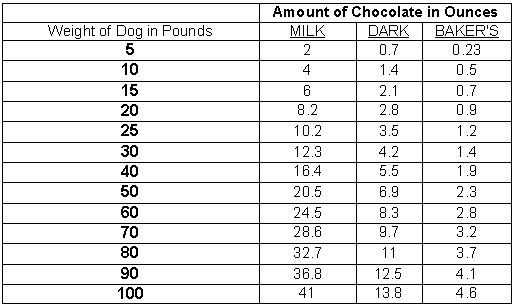
It's a scary thought, but just a little chocolate can harm your pet. Ensure you keep all the sweets out of your pet's reach this Valentine's Day!
Number of OUNCES of CHOCOLATE a pet would need to ingest for TOXICITY to be:

Understanding Chocolate & Where It Comes From
Let's go back and learn where chocolate is made. Cacao trees are farmed as any other crop, though they grow in tropical regions. The cacao tree's fruit (called a cacao pod) is sweet and attracts monkeys or other wildlife who eat the fruit but not the bitter seeds. The seeds are discarded in the natural setting, thus allowing new trees to grow.
The seeds cannot be released from the fruit unless some animal breaks the fruit open. Ironically, the bitter seeds, packed with theobromine and caffeine, are used to make chocolate. The pods grow directly off the trunk of the cacao tree and must be harvested by hand so as not to damage the tree. The pods are split, and the seeds are scooped out and left to ferment under banana leaves for about a week. This turns the cacao seeds into a rich brown, creating the chocolate flavor we crave. The seeds are dried out for another week, packed in sacks, and shipped to chocolate manufacturers.
The seeds must be roasted, ground, pressed (which removes the seed's oil, the "cocoa butter" used in sunscreens, white chocolate, and cosmetics, among other things), and tempered to create the exact consistency.
Chocolate liquor is the liquid that results from grinding the hulled cacao beans.
Cocoa butter is the fat that is extracted from the chocolate liquor.
Cocoa powder is the solid that remains after the cocoa butter is removed from the chocolate liquor. The powder can be treated with alkali in a process called "Dutching" or left alone. Note the low-fat nature of cocoa powder, hence its use in low-fat baking.
Unsweetened chocolate is chocolate liquor 50% to 60% cocoa butter. Semisweet chocolate is 35% chocolate liquor (the rest being sugar, vanilla, or lecithin).
Milk chocolate is at least 10% chocolate liquor, the rest being milk solids, vanilla, or lecithin.
Why Is Chocolate Bad for Pets?
Sometimes we eat chocolate plain. Sometimes, we eat it baked into cakes, mixed into ice cream, etc. The first problem with these sweets is the fat. A sudden high-fat meal (such as demolishing a bag of chocolate bars left accessible at Halloween time) can create a lethal metabolic disease in pets called pancreatitis. Vomiting, diarrhea, and abdominal pain are just the beginning of this disaster. Remember, in the case of pancreatitis, the fat causes the problem more than the chocolate itself.
The fat and sugar in the chocolate can create an unpleasant but temporary upset stomach. This is what happens in most chocolate ingestion cases.
Chocolate is, however, directly toxic because of the theobromine. The more chocolate liquor in a product, the more theobromine is present. This makes baking chocolate the worst for pets, followed by semisweet and dark chocolate, milk chocolate, and chocolate-flavored cakes or cookies. Theobromine causes:
Vomiting
Diarrhea
Hyperactivity
Tremors
Seizures
Racing heart rhythm progressing to abnormal rhythms
Death in severe cases
Toxic doses of theobromine are 9 mg per pound of dog for mild signs and up to 18 mg per pound of dog for severe signs. Milk chocolate contains 44 mg/ounce of theobromine, while semisweet chocolate contains 150 mg per ounce, and baking chocolate contains 390 mg per ounce.
It takes nearly four days for the effects of chocolate to work its way out of a dog's system. If you catch your dog in the act of eating the chocolate and treat it immediately, vomiting can be induced; otherwise, hospitalization and support are needed until the chocolate has worked its way out of the system.
Tags: chocolate toxicity, pet toxins, urgent care







